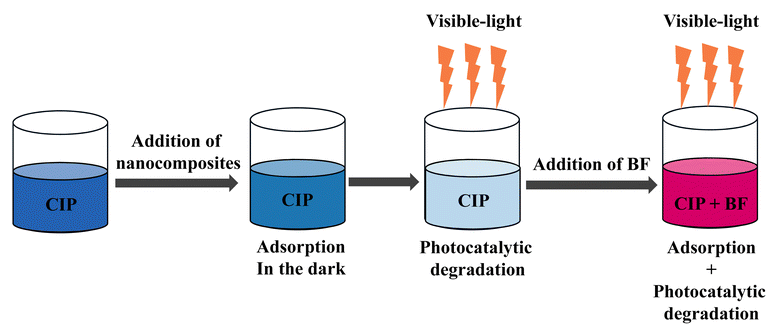Water pollution is a growing concern for mankind due to its harmful effects on humans, animals and plants. Usually, several pollutants are present in wastewater. For example, dyes and antibiotics are found in wastewater because of their widespread use in factories and hospitals. However, one single technique, e.g. either adsorption or photocatalysis, cannot easily remove more than one kind of pollutant, especially by using one single material in water. For this reason, here multifunctional iron(II,III) oxide/poly(N-isopropylacrylamide-co-methacrylic acid)/silver-titanium dioxide (Fe3O4/P(NIPAM-co-MAA)/Ag–TiO2) nanocomposites were used to remove a mixture of pollutants from water. Specifically, three types of experiments were performed to evaluate the adsorption capacity and photodegradation activity of the nanocomposites towards the dye basic fuchsin (BF) and the antibiotic ciprofloxacin (CIP), which were added sequentially to the nanocomposites dispersion or were concurrently present as a mixture. The results demonstrated that the nanocomposites could adsorb BF, and subsequently photodegrade CIP under visible-light irradiation, if BF was the first added pollutant. As well, the nanocomposites could first degrade CIP under visible-light irradiation, and then adsorb BF if they were initially put in contact with CIP. Finally, the ability of adsorbing BF and photodegrading CIP was confirmed in the co-presence of the two pollutants.

Water pollution is a growing concern for mankind due to its harmful effects on humans, animals and plants. Usually, several pollutants are present in wastewater. For example, dyes and antibiotics are found in wastewater because of their widespread use in factories and hospitals. However, one single technique, e.g. either adsorption or photocatalysis, cannot easily remove more than one kind of pollutant, especially by using one single material in water. For this reason, here multifunctional iron(II,III) oxide/poly(N-isopropylacrylamide-co-methacrylic acid)/silver-titanium dioxide (Fe3O4/P(NIPAM-co-MAA)/Ag–TiO2) nanocomposites were used to remove a mixture of pollutants from water. Specifically, three types of experiments were performed to evaluate the adsorption capacity and photodegradation activity of the nanocomposites towards the dye basic fuchsin (BF) and the antibiotic ciprofloxacin (CIP), which were added sequentially to the nanocomposites dispersion or were concurrently present as a mixture. The results demonstrated that the nanocomposites could adsorb BF, and subsequently photodegrade CIP under visible-light irradiation, if BF was the first added pollutant. As well, the nanocomposites could first degrade CIP under visible-light irradiation, and then adsorb BF if they were initially put in contact with CIP. Finally, the ability of adsorbing BF and photodegrading CIP was confirmed in the co-presence of the two pollutants.
